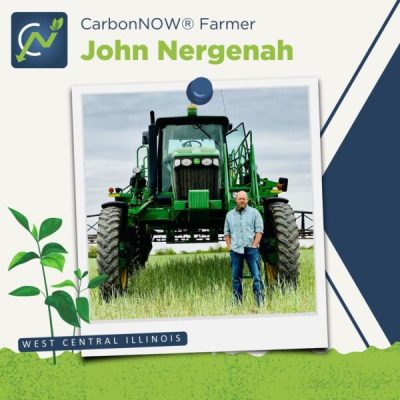A Morgan County farmer is a part of the latest buzz in agriculture.
Carbon Farming is a whole farm approach to optimizing carbon capture on working landscapes by implementing practices that are known to improve the rate at which CO2 is removed from the atmosphere and stored in plant material and/or soil organic matter.
John Nergenah of rural Chapin says he started farming with his father 20 years ago with corn and soybean rotation. He says the operation has been 100% no-till since 2016 after he noticed some adverse effects to his ground: “Around 2016, we were still doing corn and bean rotation. We were having more erosion than I liked to see. I started researching cover crops, no till, and regenerative ag in general. That was when we made the switch and went 100% no-till with cover crops. Then, that led into the carbon markets. We didn’t really look to get into carbon markets. It was one of the bi-products of changing the way that we farm. We were already doing all of those things so we just thought we’d maybe go ahead and get paid for what we’re doing.”
Nergenah joined into the CarbonNOW carbon farming program through Locus Agriculture Solutions. According to a press release from the company, they have paid out $1.2 million in carbon payments to Illinois farmers. A profile done by the company on Nerganah’s farm shows that he’s been paid $9 per acre for 1000 acres he has enrolled in the program, with the potential to earn an additional $3 per acre with soil testing done this Fall.
Nergenah says one benefit of his practices is that he’s seeing reduced input costs with cover crops: “We have reduced our herbicides probably close to half of what we were doing before. When you have that green-growing plant, those cover crops, they kind of shade out any other weed. We haven’t completely gotten away from residual herbicides, but I think we will eventually be able to even drop all residual herbicides. With pests, it’s kind of a timing issue. We went to planting our beans first because they can handle the cold and shady stuff better than corn. We went to planting our corn in mid-May, which by that point a lot of the pests that you would have problems with have already left the fields.”
Nerganah says they’ve also been able to save on fertilizer costs as well: “We continue to try and cut back on stuff a little bit more every year – nitrogen, PK, everything. In conservation tillage practice or full-width tillage, the amount of erosion takes a lot of those nutrients because many of those nutrients are right on top of the ground. With having cover crops and no till, we are retaining all of that.”
Nergenah says if you’re unsure about the practices or the carbon markets, don’t sign up your whole farm all at once but to try it on a small scale and see what works best for your own operation. Nergenah says the process of starting no-till and carbon farming is much easier now than when he started 6 years ago.




